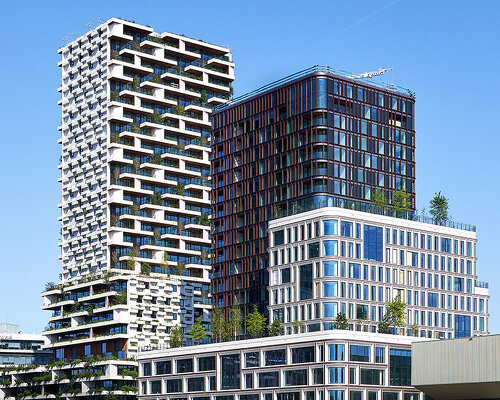stefano boeri completes his vertical forest in Utrecht
Following his groundbreaking Bosco Verticale in Milan and the social housing version in Eindhoven, Stefano Boeri Architetti‘s Wonderwoods Vertical Forest blossoms in Utrecht (find designboom’s previous coverage here), the tallest of its kind in the Netherlands. Rising 104 meters above the Beurskwartier district, the green tower is described by the studio as a ‘building/city’ and a complex ecosystem. The project continues Boeri’s decade-long pursuit of architecture that nurtures biodiversity, public life, and environmental responsibility.
Located near Utrecht’s central station, Wonderwoods is part of a two-tower development designed in collaboration with MVSA Architects. Stefano Boeri Architetti’s Vertical Forest tower is an evolving habitat made of 360 trees and 50,000 plants across its terraces and balconies. ‘Our Vertical Forest in Utrecht is a fundamental stage in the research we are carrying out all over the world,’ says Boeri. ‘The building hosts a combination of considerable vegetal biodiversity and a wide range of functions, including exhibitions, commercial, tertiary, and residential uses, as well as hospitality options. It will be a real building/city as well as a rich and complex ecosystem.’
all images by Lorenzo Masotto, unless stated otherwise
Wonderwoods is a living tower that breathes
True to its name, Stefano Boeri’s Vertical Forest building actively supports non-human life. The Milan-, Shanghai- and Tirana-based architecture studio punctuates the facades with circular openings that are used as nesting spaces for native bird species. The selection of 30 local plant species changes the appearance of the facades over the course of the year. This living skin responds to light, temperature, and plant growth, making the tower an expressive participant in the urban environment rather than a static object.
Constructed using a novel prefabrication system for both balconies and facades, the tower marks a first for this typology. It rotates along its vertical axis in four superimposed ‘orders’, aligning with sunlight and views rather than the rigid street grid of Croeselaan. This gesture enables a physical connection at the seventh floor with the neighboring MVSA building, where a green pedestrian bridge hosts restaurants and panoramic views. Below, a water management system reclaims and filters rainwater for sustainable reuse.
Stefano Boeri Architetti’s Wonderwoods Vertical Forest blossoms in Utrecht | image ©Milan Hofmans
part of a broader architectural vision
The building’s ground floor and basement host public spaces and ample bicycle parking, while its upper levels combine offices, fitness areas, and a network of duplex apartments that double as residential ateliers. Designed as a fully pedestrian zone, the surrounding area integrates sustainable systems such as a subterranean reservoir that captures, reclaims, and manages rainwater. Following the Trudo Vertical Forest social housing project in Eindhoven, Wonderwoods becomes the first of Boeri’s green towers in the Netherlands to include public-facing amenities, advancing his vision for accessible, ecologically engaged architecture as part of the city’s everyday life.
Inside, more than apartments, many of them duplexes, are designed for diverse occupants, with generous outdoor spaces and smart greenery management systems that monitor irrigation and schedule pruning. The lower floors accommodate public amenities, including bicycle parking, fitness areas, and commercial spaces, reinforcing the building’s role as a vertical neighborhood.
The Wonderwoods Vertical Forest, in line with Stefano Boeri Architetti’s broader architectural vision, represents a new way of thinking about how cities and nature can coexist. By winning the MIPIM Award, the project has been recognized for its forward-thinking approach to sustainable urban living. A decade after Milan’s Bosco Verticale showed the world that greenery can be an integral part of high-rise architecture, Wonderwoods carries that idea forward.
rising 104 meters above the Beurskwartier district | image ©Milan Hofmans
a green pedestrian bridge hosts restaurants and panoramic views
the green tower is described by the studio as a ‘building/city’ | image ©Milan Hofmans
an evolving habitat made of 360 trees and 50,000 plants | image ©Milan Hofmans
30 local plant species change the appearance of the facades | image ©Milan Hofmans
lush terraces and balconies | image ©Milan Hofmans
Wonderwoods is part of a two-tower development
this living skin responds to light, temperature, and plant growth
an expressive participant in the urban environment
Wonderwoods becomes the first of Boeri’s green towers in the Netherlands to include public-facing amenities
project info:
name: Wonderwoods Vertical Forest
architect: Stefano Boeri Architetti | @stefanoboeriarchitetti
location: Utrecht, the Netherlands
height: 104 meters
partner + project director: Francesca Cesa Bianchi
developer: G&S& | @gensamsterdam
local architect: INBO | @inboarchitects
collaborating tower design: MVSA Architects | @mvsa_architects
landscape design (facades): Laura Gatti | @studiolauragatti
landscape design (roofs): ARCADIS Landschapsarchitectuur
structural engineering: Van Rossum
general contractor: Boele & van Eesteren
landscape contractor: Koninklijke Ginkel Groep
The post stefano boeri’s vertical forest blooms in utrecht with 50,000 plant facade appeared first on designboom | architecture & design magazine.

